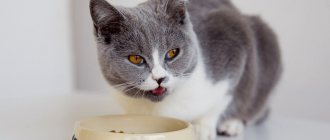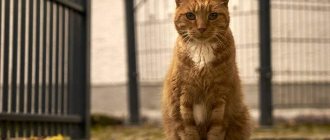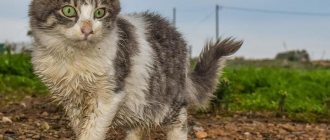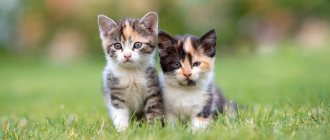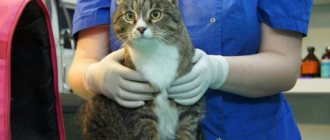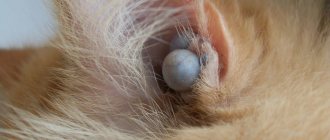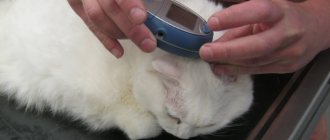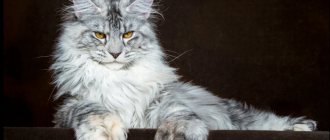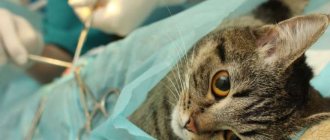As you know, a cat’s tail is a kind of “mood pendulum” for these animals. If your pet is excited or dissatisfied with something, she begins to jerk it vigorously. In addition, some cats are even able to “inform” their owners about their mood with the expressive bends of their tail.
If you are attentive and curious, then with the help of this Morse code you can quickly establish a relationship with your pet. But it happens that the cat’s tail takes on some unnatural positions, which immediately worries the breeders. Do you know why a cat's tail becomes curled, and what this phenomenon can mean? If not, then you can find out about it from our article!
Types of tail deformation
Tail deformation can be of several types; the most common are kinks, kinks and bends. When a bend occurs, the next vertebra of the tail rises above the previous one, resulting in the formation of a “step up the ladder.” Deformed vertebrae differ in size and have rounded edges.
The opposite defect is a fracture, in which the vertebrae are located “step down”.
The bend is clearly visible to the naked eye; it seems that several vertebrae have “jumped out” beyond the imaginary line that runs through the middle of the vertebrae from the base to the tip of the tail. The bodies of the protruding vertebrae often have a wedge-shaped shape.
Symptoms of the disease
Fat tails are much more common in male cats than in male cats. As noted above, animals with short fur are at risk, which complicates the diagnostic process. Let's try to find out what signs clearly demonstrate this disease:
- The epithelium at the base of the fur becomes lumpy, it flakes off and becomes covered with a thin crust of pus.
- The tail, most often at the junction with the body, is thickly covered with fat, which makes the fur begin to shine. The discharge cannot be washed off with shampoo or soap.
- If the disease progresses, the skin at the site of localization will be combed and covered with red pimples. This is how the animal tries to relieve the itching, but only spreads the infection through the skin.
- The area of “greasy” fur becomes exposed over time. This is due to the fact that the hairs gradually break off at their base.
- A symptom that the anus is inflamed may be uncharacteristic behavior when the cat crawls with its butt on the carpet, trying to release excess contents.
- Over time, brown spots may appear on your pet's tail; if left untreated, they will develop into a hard crust, tearing which the cat will injure itself.
Owners who notice that their animal has developed “greasy tail” syndrome should under no circumstances dismiss this problem, attributing it to seasonality or simply the cat’s untidiness. Most often, the true cause lies precisely in a serious illness that has just begun to manifest itself. If you react promptly, it will save a lot of hassle for both the owners and the cat.
Treating a cat's fatty tail is a long and tedious process. You need to start with a trip to the veterinarian, who will determine exactly what caused the disease and how to eliminate it as quickly as possible. Treatment, as a rule, is based on the fact that the pet begins to take baths more often. To do this, you need to buy special shampoos containing lactic acid. This will perfectly exfoliate harmful keratin accumulations and cleanse the skin, which will create the basis for subsequent therapy.
If the veterinarian determines that the greasy tail is caused by a hormonal disorder, then castration of the pet or medication to stop the production of sex hormones will be required. Excessive production of anal secretions is treated with rinsing. The specialist will clearly explain to the owners how this is done. If the disease recurs regularly, the anal glands can be completely removed surgically.
If the causes are caused by external irritants, then a complex of vitamins and a special diet are prescribed to strengthen the immune system. All this will help the cat become beautiful again, and its owner - calmer. If you ignore the fact that your pet’s tail becomes fat, then in the future this can lead to complete baldness, which will make the animal completely unsightly.
Fat tail on a cat treatment
Why is the tail “broken”
Kittens with tail deformities can appear in litters of both outbred and purebred cats. Instead of a straight tail, the owners see tails bent to the side, broken in several places, or hooked. Regardless of the type of deformity, such a deviation permanently prohibits access to breeding and exhibitions. A fluffy kitten can become an excellent pet that retains all the characteristics of the breed, but the animal forever falls into the “home only” category.
Slight miscorrection of the tail, which is expressed in the last and penultimate vertebrae, is acceptable in some breeds, but breeding animals in such a situation is not recommended.
Veterinarians and breeders say that “unique” tails indicate the degeneration of the breed and are a serious genetic defect. When breeding such animals, you put all the offspring at risk, since the next generations may have not only a crooked tail, but also serious spinal disorders. Curvature of the spine is a direct path to congenital pathologies of internal organs, as a result of which the offspring will be non-viable.
The exact nature of such genetic abnormalities has not been established, but assumptions agree that closely related relationships are to blame.
Maine Coon health and life expectancy
Maine Coons can “boast” not only of their outstanding size, but also of good health.
They practically do not get sick, since they have good immunity from birth. A Maine Coon cat can live 15–20 years. To rule out urolithiasis, you need to take your pet to the veterinarian once every six months. To prevent this problem, the Maine Coon must eat properly and receive the necessary care.
Proper nutrition and proper care of the animal will help prevent the onset of urolithiasis, which is typical for Maine Coons.
The animal may have joint problems. However, a kitten leaves the nursery for a new family usually at the age of 12 weeks. At this time, joint pathologies are immediately visible. To avoid problems with the health of the animal, it is better to take it from those breeders whose reputation is impeccable.
A Maine Coon has been living in my friend's family for 3 years. During this time, the cat has not had any illnesses, he is cheerful, cheerful and eats well.
Types of tail deformation
Tail deformation can be of several types; the most common are kinks, kinks and bends. When a bend occurs, the next vertebra of the tail rises above the previous one, resulting in the formation of a “step up the ladder.” Deformed vertebrae differ in size and have rounded edges.
The opposite defect is a fracture, in which the vertebrae are located “step down”.
The bend is clearly visible to the naked eye; it seems that several vertebrae have “jumped out” beyond the imaginary line that runs through the middle of the vertebrae from the base to the tip of the tail. The bodies of the protruding vertebrae often have a wedge-shaped shape.
Tail amputation as a medical procedure
It is carried out for non-healing wounds, fractures, ulcers, necrosis and neoplasms of the tail.
Amputation of the tail in case of damage is carried out under general anesthesia. In this regard, as before any surgical intervention, it is necessary to conduct a preoperative examination of the animal to exclude possible contraindications to anesthesia. Preoperative preparation includes taking clinical and biochemical blood tests, and, if necessary, performing an x-ray and ultrasound.
Before surgery, the animal is kept on a fasting diet for at least 8 hours. The surgical technique and the size of the amputated section of the tail are determined by the veterinarian based on the degree of damage to the tail. The animal wears a protective collar until the stitches are removed. Sutures are usually removed within 10-12 days. In case of tumors of the tail after surgery, it is necessary to send the amputated area for histological examination to determine the nature of the tumor.
Why is the tail “broken”
Kittens with tail deformities can appear in litters of both outbred and purebred cats. Instead of a straight tail, the owners see tails bent to the side, broken in several places, or hooked. Regardless of the type of deformity, such a deviation permanently prohibits access to breeding and exhibitions. A fluffy kitten can become an excellent pet that retains all the characteristics of the breed, but the animal forever falls into the “home only” category.
Slight miscorrection of the tail, which is expressed in the last and penultimate vertebrae, is acceptable in some breeds, but breeding animals in such a situation is not recommended.
Veterinarians and breeders say that “unique” tails indicate the degeneration of the breed and are a serious genetic defect. When breeding such animals, you put all the offspring at risk, since the next generations may have not only a crooked tail, but also serious spinal disorders. Curvature of the spine is a direct path to congenital pathologies of internal organs, as a result of which the offspring will be non-viable.
The exact nature of such genetic abnormalities has not been established, but assumptions agree that closely related relationships are to blame.
Comments
Of course, it can be straightened - if the last and penultimate vertebrae (not higher) are broken, they can be quickly removed, and if the judges don’t take an x-ray, they won’t guess (with good plastic surgery of the tip) that there’s something wrong with the tail. Another question is ethical. Even two.
1. Is it worth torturing a kitten with surgery under general anesthesia for the sake of “beauty”? The gym does not interfere with his life at all. 2. Is it worth breeding an animal that has a gall, because it is inherited.
If I got such a kitten, I would probably talk to his breeders and ask for part of the money back - the difference between a show class and just a favorite. I would present an x-ray as a document explaining the reasons.
Thank you, part of the question is whether tail straightening surgery will be painful or difficult during and after, and whether it can affect the kitten’s psyche. It is the very last or penultimate vertebra that is broken. In fact, now, while the kitten's tail is not yet pubescent, this can be seen quite clearly. But maybe over time the tail will become pubescent, as is typical for the tails of Maine Coons - at the end there will be a bunch of these long flying strands of feathers, then perhaps the flaw will be less noticeable.
The kitten was not sold for breeding. There are now only three coon nurseries in Israel and all hold breeding licenses - and only sell castrated kittens - for exhibitions and as pets.
We took a cat from a litter in which three kittens were born with short, half-length tails. Ours and the other one came out normal - so it seemed to us. Now it’s clear why the owners of the nursery said that they wanted to close the case - their pair of sires had a useless genetic line. When we agreed on the purchase, we were not yet sure that we would want to participate in exhibitions, so this point was not particularly discussed. In a month of waiting until the cat reaches 3 months of age, he will be castrated and given to us - they matured, got tired of waiting, rushed over and took the cat almost without hesitation.

